The pilgrimage on the Camino from Sarria to Santiago de Compostela is an unforgettable experience. The Camino de Santiago is an old pilgrimage route to the tomb of the Apostle St.James in the Cathedral of Santiago de Compostela.
The history of the Camino de Santiago goes back to the 9th century when the actual tomb of the Apostle was discovered. The first officially documented pilgrimage to Santiago was made by the king of Asturias and Galicia Alfonso II in the 9th century on the Camino Primitivo or the Original Way from Oviedo to Santiago.

Nowadays more than 300 000 people from all over the world walk the Camino every year. The Camino Francés from Sarria is the most popular Camino de Santiago route. According to the Pilgrim’s Reception Office in Santiago in 2023, 131 136 people, or 30,8% of all pilgrims walked this route. The Portuguese Camino from Tui is the second most popular route walked by 7,7% of pilgrims.
Table of Contents
Camino from Sarria free downloadable PDFs
Download our free PDF files for the Camino Francés from Sarria with detailed walking stages and places to stay along the route.
GPX files of the route
Camino with a tour
If you’re concerned about planning the walk from Sarria yourself you can book your Camino through a company. They do all the planning and booking for you and provide you with a detailed itinerary. All you have to do is walk.
The route overview
- Total distance – 116 km/72 mi
- Days required – 5 days
- Walking surface – 45 km/28 mi asphalt, 71 km/44 mi footpath/gravel road
- Total ascent (over 5 days) – 2373 m
- Total descent – 2587 m
- Average cost – 25-30 Euro per person per day (if staying in dormitories), 40-45 Euro pp. per day (if staying in private rooms).
- Accommodation – municipal and private albergues (hostels for pilgrims), hotels, and guest houses.
- Route marking – yellow arrows and shells painted on trees, walls, ground, etc., and distance poles that show how many kilometers are left to Santiago.
How long is the Camino de Santiago from Sarria?
The distance of the Camino walk from Sarria to Santiago de Compostela is 116 km/72 mi. It takes 5-7 days on average to complete the route.
How hard is the walk from Sarria?
The Camino from Sarria is a challenging route, especially for those who have never done multi-day walking/hiking before. It’s recommended to prepare for the Camino before attempting the walk.
This part is the busiest and the most crowded on the Camino de Santiago in season be ready to see hundreds of pilgrims. It’s better to book places to stay in advance if you’re planning to walk between May and September.
The last 100 km on the Camino Francés vs on any other Camino
The French Way from Sarria is not the only option for walking the required minimum of 100 km to Santiago to get the Compostela. You can walk it on any other Camino route e.g. Camino Portugués, Vía de la Plata, Camino Inglés, Camino Primitivo, or Camino del Norte (the last two merge with the French Camino in Melide and Arzúa respectively).
You can walk the last 100 km on any Camino de Santiago route
Travel insurance for the Camino
Read about suitable travel insurance for the pilgrimage in our Travel insurance for the Camino post or get an instant personalized insurance quote for your trip right now.
World Nomads travel insurance has been designed by travelers for travelers, with coverage for more than 150 activities as well as emergency medical, lost luggage, trip cancellation and more.


When is the best time for walking?
Heat is not the biggest problem in Galicia it might be quite warm in July and August. From our experience rain is more of a problem here May to September weather-wise is the best period for walking. The end of August and the beginning of September is the busiest time on the Camino Frances. The second half of May, June, and September are probably the best months to do the Camino de Santiago; the weather is nice (it might still rain), the days are long and there are not too many people.
If you walk this route off-season from October to April you might get quite a lot of rain and even snow in January – February.
The cost of the Camino Francés from Sarria
Accommodation. The cheapest option is municipal albergues a bed in one of them costs 8 Euro. It used to be cheaper between 5 and 7 Euro but now a bed in all public albergues in Galicia costs 8 Euro. Private albergues are more expensive 10-12 Euro per bed but they’re smaller and more comfortable. A single private room costs 25-30 Euro, a double room – 35-40 Euro.
Food. Menu del Día or Pilgrim’s Menu is the most popular set meal on the Camino you can get it for lunch and sometimes dinner. It’s a set menu that includes a starter (usually soup, salad, or pasta), the main dish (meat, chicken, fish, vegetarian, egg and bacon, etc.), a bread basket, a drink (beer, house wine, cooldrink or water) and dessert or coffee. The average price is 10 Euro. Breakfast (coffee, juice, croissant/sandwich/toast) is between 3 and 4 euros. Food on the Camino de Santiago is a part of the experience. Don’t forget to try some of the local specialties such as Pimientos de Padron, Pulpo a la Feira, and Tarta de Santiago.
Shopping. It’s cheaper to buy food in a supermarket and cook for yourself, especially if you’re a couple of people cooking together, just make sure the place you’re going to stay has a kitchen. To buy food for lunch and dinner will cost 6-8 Euro per person on average.
Luggage transfer. 5 Euro per backpack per stage, for 5 days it’ll be more or less 25 Euro per person.
Transport. Train Madrid to Santiago for 33 Euro one way. A one-way flight to Santiago from Madrid with Ryanair (if you buy it in advance) is about 15-20 Euro without check-in luggage. It’s more expensive and longer to get to Santiago from Barcelona, by train it takes about 10 hours, there are some flights for 20-30 Euro one way.
Laundry. 3 Euro per load for washing, 3-4 Euro per load for drying. The machines are quite big you can share a load between two or three people which is cheaper and better for the environment. I washed socks, underwear, and shirts by hand every day and every 4th or 5th day did machine laundry.
My detailed budget breakdown
For 5 days for 1 person
- Accommodation (5 nights) – 84 Euro, 3 nights in dormitories, and 2 nights in private. If you stick to dormitories the cost can be as low as 50 Euro.
- Eating out – 45 Euro, 1 Menu del Día, many sandwiches and tortillas
- Food shopping – 47 Euro
- Coffee, wine, beer – 10 Euro
- Laundry – 3 Euro
- Transport – 72 Euro; train Madrid-Santiago-Madrid – 66 Euro. Bus Santiago-Sarria – 6 Euro (online discount). Note! I took only the Santiago-Madrid train I arrived in Sarria walking as I started the Camino in St.Jean Pied du Port.
Total: 261 Euro or 52 Euro per person per day including transport, accommodation, food, etc. If you use luggage transfer add 5 Euro to your daily budget.


What is the accommodation like on the Camino from Sarria?
There are different types of accommodation on the Camino you can stay in shared dormitory rooms which will be the cheapest option or in private rooms in hotels or guest houses/pensions depending on your budget. Special hostels for pilgrims on the Camino are called albergues, they can be municipal (subsidized by the municipality, the cheapest option) or private (a bit more expensive but usually with better facilities).

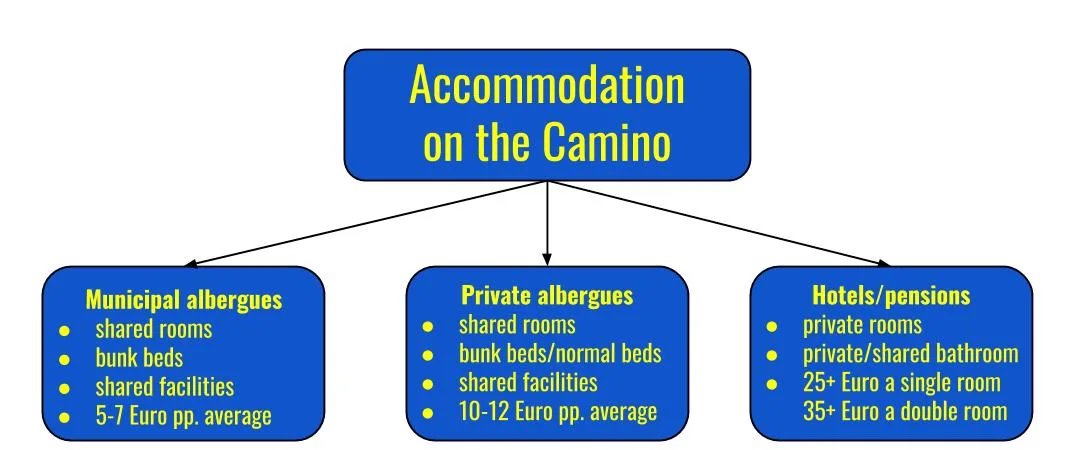
Albergues usually have one or two big rooms with several bunk beds each, shared toilets and showers, and a shared kitchen. Sometimes more expensive private albergues have normal single beds instead of bunk beds. An albergue is a hostel with dorm beds and shared facilities. Municipal albergues are exclusively for pilgrims to be able to stay there you have to present your Credential (pilgrim’s passport). Private albergues let anybody stay; pilgrims, tourists, students, etc.
Municipal albergues facilities
- Hot shower
- Electricity
- Kitchen (usually)
- Washing machine (sometimes)
- Blankets (usually but not always)
- Wi-fi (usually)
Private albergues facilities
- Hot shower
- Electricity
- Kitchen (usually)
- Washing machine (usually)
- Blankets (usually)
- Wi-fi
If you rather stay in a private room than in a dormitory there are many hotels and guest houses or pensions along the Camino. They’re more expensive but more comfortable. When we walk the Camino we try to mix albergues and hotels and stay once or twice a week in private, It might be not a big issue if you walk for less than a week but when you walk a longer route that takes a month you get pretty tired of staying in dormitories.
My advice is if you’re planning to walk the Camino in peak season from May to September book private accommodation at least a couple of days in advance. In my experience of walking in September, sometimes it was difficult to find a private single room on arrival everything was fully booked.
What to pack for the pilgrimage?
A very important thing to remember is not to pack a lot of stuff if you’re planning to carry your backpack yourself. The lighter it is the easier the walk is. Take only the necessary things that you’re going to need. If you’re planning on using a luggage transfer service you can pack as much as you wish (note that usually your luggage is limited to 20-25kg per person). You can find more details on what to pack for the Camino in our Camino de Santiago packing guide.
Footwear is the most important item for the pilgrimage. Make sure you choose comfortable shoes for walking the Camino and a good Camino backpack.
Backpack delivery on the route
It’s possible to arrange luggage transfer from door to door every day. There are a couple of companies that deliver luggage on the Camino from Sarria e.g. Correos, Xacotrans, Pilbeo, and others. It’s a very simple system in the morning you put your backpack/suitcase in the reception area with an envelope that contains the address of your next place, your name, phone number, and 5 Euro for delivery. The courier comes in the morning to pick up the backpacks. Usually, by the time you arrive at the next place, your luggage is already there.
Sarria to Santiago route map


How to get to Sarria?
Madrid is probably the best city to fly into, there are many transport options from there. If you’re starting the Camino in Sarria the best option will be to fly to Santiago. A return flight from Madrid with Ryanair will cost 30-40 Euro (if you book in advance), this fare doesn’t include check-in luggage. There are flights from Barcelona as well for about 50 Euro return. There are many flights to Santiago from different cities in Spain and Europe. If you have an international flight you can fly to Madrid or Barcelona first and then catch a local flight to Santiago.
A train ride from Madrid to Sarria is 30-40 Euro one way, it can be booked online. There are no direct trains from Barcelona to Sarria. To get there from Barcelona by train, you’ll have to take a train from Barcelona to Santiago first and then take a bus from Santiago to Sarria. The train ride from Barcelona to Santiago is an exhausting journey, it takes between 10-12 hours, and we’ve done it once.
From Santiago de Compostela you can take a bus to Sarria. The journey takes 2 hours and costs 10 Euro sometimes they have special discounts if you buy online.
Where to stay in Sarria?
If you’re going to walk the Camino in the peak season (May-September) and going to arrive in Sarria after lunchtime I’d recommend booking a place to stay beforehand. There are many albergues and hostels in the town I’m sure you’ll be able to find a dorm bed but if you want to stay in a private room booking in advance is recommended. There is a municipal albergue in Sarria at Rúa Maior, 79. It can’t be booked in advance like most public albergues on the Camino. Price – 8 Euro per person.
Albergues and hotels in Sarria
Where to get a Pilgrim’s Passport (Credential) in Sarria?
Every pilgrim needs the Credential with stamps (two stamps per day for the last 100 km) from albergues, hotels, restaurants, or churches to get the Compostela in Santiago. You’ll need it as well as proof if you’re planning to stay in municipal albergues as they’re exclusively for pilgrims. Private albergues and hotels don’t require it. You can get a Credential in Sarria in the Church of Santa Mariña de Sarria, Monastery La Magdalena, and some private albergues sell Credentials as well.
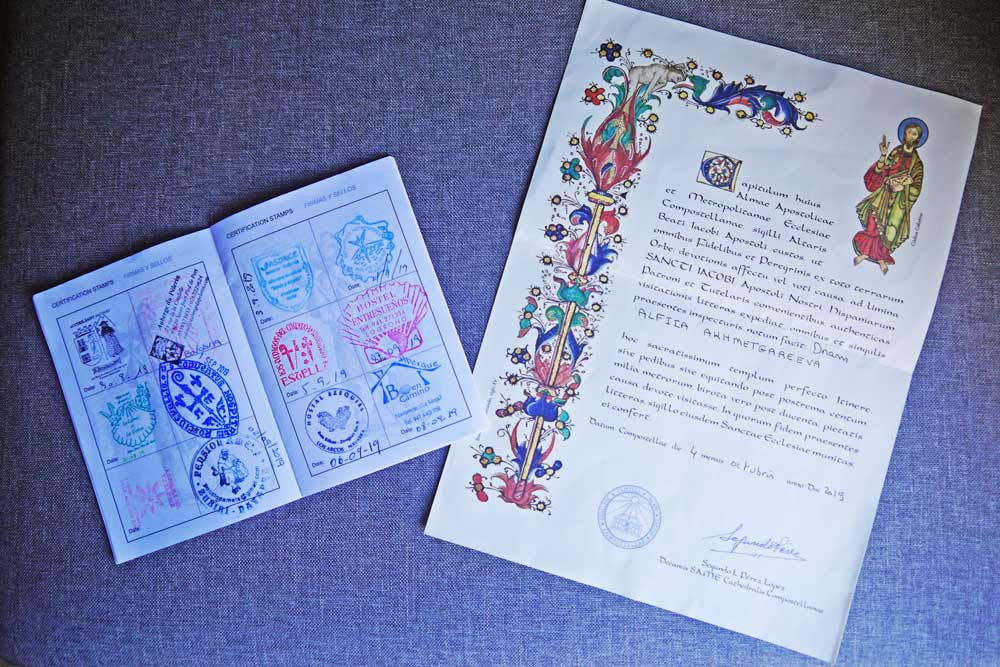

Camino Francés from Sarria walking stages
Day 1. Sarria to Portomarín, 22 km/13,6 mi
- Distance – 22 km/13,6 mi
- Time – 4h20min.*
- Walking on asphalt – 13 km/8 mi
- Walking on the road – 500m
- Ascent – 496m
- Descent – 570m
- Difficulty level – 2 out of 5
*All given times don’t include stops on the way, it’s pure walking time. I walk quite fast I’d suggest adding 1-2 hours to my time (depending on your fitness level).


If you start in Sarria and it’s the first walking day for you. I strongly recommend taking it easy, stopping for a rest on the way, drinking enough water, and don’t try to chase after other walkers. There will be some pilgrims who have been walking for weeks and they are definitely in better walking shape since they are already used to it.
On the way, there will be a couple of places (farms) selling local homemade products like jams, bread, cheese, etc. Everything is very fresh and tasty.
Highlights
- A nice and peaceful countryside scenery; chestnut and oak forest, small farms and villages, wheat fields.
- The beautiful town of Portomarín with its cozy streets, inviting restaurants, an interesting church, and stunning views over the lake Embalse de Belesar. A very interesting thing about the town is that in 1963 it was completely flooded, and some historical buildings like
San Nicolás Church or Chapel de la Nieves was moved higher uphill where you can find them nowadays.
Challenges
- An easy walking day with several short ascents and descents mostly in the first half.
- A rocky and steep descent just before Portomarín.
More accommodation options in Portomarín*
*The complete list of accommodations along the route you can find in our free PDF file.


Day 2. Portomarín to Palas de Rei, 25 km/15,5 mi
- Distance – 25 km/15,5 mi
- Time – 4h30min.
- Walking on asphalt – 3 km/1,8 mi
- Walking on the road – not really walking on the road but quite a lot of walking on the gravel path next to the road
- Ascent – 580m
- Descent – 431m
- Difficulty level – 3 out of 5


It was a nice walking day a bit tougher and longer than Day 1 with many places on the way to stop for lunch or coffee. Most of the route goes through the forest and fields sometimes next to the road with very few cars.
Highlights
- Beautiful Galician forest.
- A couple of stalls with fruit, snacks and cool drinks for donation.
Challenges
- 350m ascent during the first half of the day.
- A couple of stretches of walking next to the road on the gravel path.
More accommodation options in Palas de Rei


Day 3. Palas de Rei to Arzua, 29 km/18 mi
- Distance – 29 km/18 mi
- Time – 5h30min.
- Walking on asphalt – 11 km/6,8 mi
- Walking on the road – 0 km
- Ascent – 588m
- Descent – 724m
- Difficulty level – 3 out of 5


It’s the longest day on the Camino from Sarria to Santiago if you don’t feel strong enough you can split it into two days, walk 15km to Melide, stay there, eat pulpo, rest and the next day walk the rest 14km to Arzúa. The Northern Camino de Santiago merges with the French route in Arzúa.
Highlights
- Melide is a pretty big town compared to the other places on the way. It’s famous for its pulpo a la Feira (cooked octopus tentacles served in olive oil and spices). It’s a must-try here, there are a couple of pulperias (restaurants that specialize in preparing pulpo) right on the Camino you won’t miss them. The Camino Primitivo merges with the French Way in Melide.
- Ribadiso de Baixo – a tiny village about 2km before Arzúa, might be a good option to finish the day if you don’t want to stay in a bigger and busier Arzúa. There are a couple of albergues here including one municipal.
Challenges
- Many short ups and downs throughout the day.
- Quite a lot of walking on asphalt, about 11 km/6,8 mi.
More accommodation options in Arzúa


Day 4. Arzúa to O Pedrouzo, 20 km/12,4 mi
- Distance – 20 km/12,4 mi
- Time – 4h.
- Walking on asphalt – 7 km/4,3 mi
- Walking on the road – 2 km/1,2 mi next to the road
- Ascent – 341m
- Descent – 468m
- Difficulty level – 2 out of 5


To be honest we’ve walked this part from Arzúa 3 times (the end of three Camino routes is the same) and never walked this last part in two days. We usually walk in one day from Arzúa to Santiago but I know it’s very far and not many people want to torture themselves like this. So I split this day into two.
Right at the exit from Arzúa, there is a split the right route continues along the road, and the left goes into the forest, we´ve always taken the left one to be away from the busy road. A couple of kilometers after Arzúa the distance marking disappears you´ll see the word Complementario instead, don’t worry about it you’re still on the right way you’ll start seeing distances again after 2km or 3km.
For most of the day you walk through the forest from time to time the Camino goes next to the road but not for long. There are many restaurants and cafes on the way to stop.
Some pilgrims make their last day shorter walk to Monto do Gozo which is just 5km outside of Santiago and stay there for the night. We’ve never stayed there but from what I’ve heard from my friends who stopped there for the night it wasn’t nice, there were cockroaches and mice and it was kind of dirty. The place doesn’t look great from the outside either we’ve never felt like staying there.
If you want to walk an extra distance I’d suggest walking to Lavacollas which is 9km from O Pedrouzo, the total distance from Arzúa will be 29km and your last day will be only 11km to the cathedral.
Highlights
- Beautiful forest, small villages, fields.
Challenges
- Several ups and downs on the way though nothing steep or long.
Places to stay in O Pedrouzo


Day 5. O Pedrouzo to Santiago de Compostela, 20 km/12,4 mi
- Distance – 20 km/12,4 mi
- Time – 3h50min.
- Walking on asphalt – 11 km/6,8 mi
- Walking on the road – 3 km/1,8 mi along a very quiet road with no cars
- Ascent – 368m
- Descent – 394m
- Difficulty level – 2 out of 5


Many people start the last day very early to make it to 12pm Pilgrim’s Mass if you start from O Pedrouzo at about 7.00-7.30am you’ll make it in time. The very beginning of the walk is beautiful; green dense forest, no cars, no houses, very quiet.
The second half from the airport and after Lavacollas is not my favorite part on the Camino there is one long stretch between Lavacollas and Monte do Gozo along the road that feels like it takes ages to walk 4-5km. Once you’re at Monte do Gozo the last 5km go very fast, you start walking through the city and don’t notice how you reach the cathedral.
Highlights
- Forest at the beginning of the day.
- Arriving at the Cathedral with the sounds of the Galician bagpipe (from morning till late evening there is always a musician playing at the Palace Arch (El Arco de Palacio) a small tunnel that leads to the Obradoiro Square and the cathedral, keep some change ready to tip the bagpipe player.
Challenges
- There are a couple of ascents and descents at the end of the walk, some of them are quite steep but not long.
- A stretch between 10 km and 15 km is a bit monotonous, it always feels long but after Monte do Gozo you enter the city, and the last 5 km are very fast.

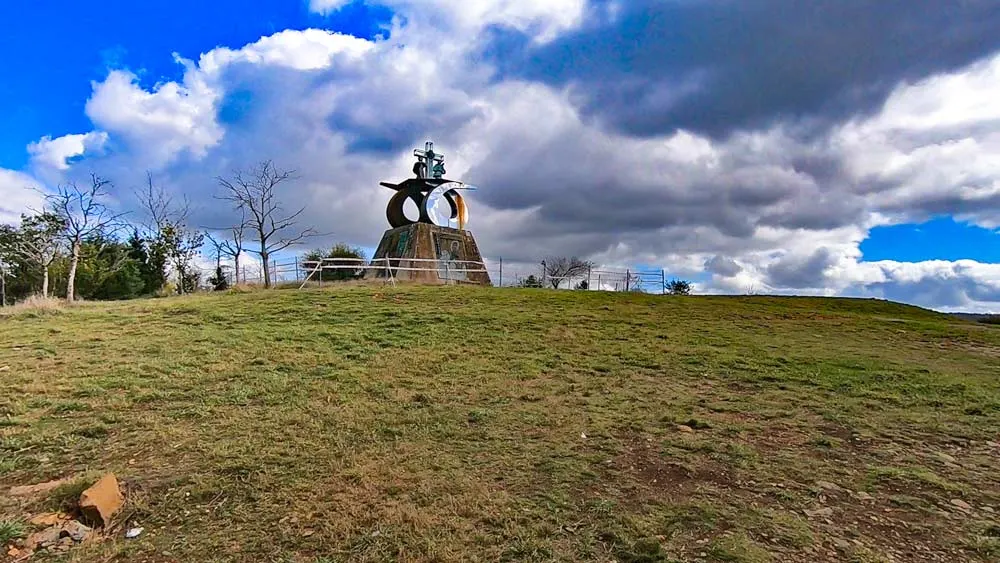
Santiago de Compostela, the end of the pilgrimage
The Camino finishes at the Cathedral de Santiago on the Plaza Obradoiro.
You’re not allowed inside the cathedral with a backpack you can go to your hotel and leave it there or go to the luggage storage which is 5min. away from the square in front of the Pilgrim’s Office, where you can leave your backpack for 24 hours for 3 Euro.
Pilgrim’s Mass takes place every day at 12 pm in the Cathedral.
Places to stay in Santiago de Compostela
There are many amazing places to stay in Santiago de Compostela. Many of the cheaper places are located outside the historic center. When you book a place, make sure it’s not too far from the cathedral if you’re planning to do some sightseeing or go out at night. We’ve been to Santiago 7 times and every time we stayed in different places (we like trying new things).

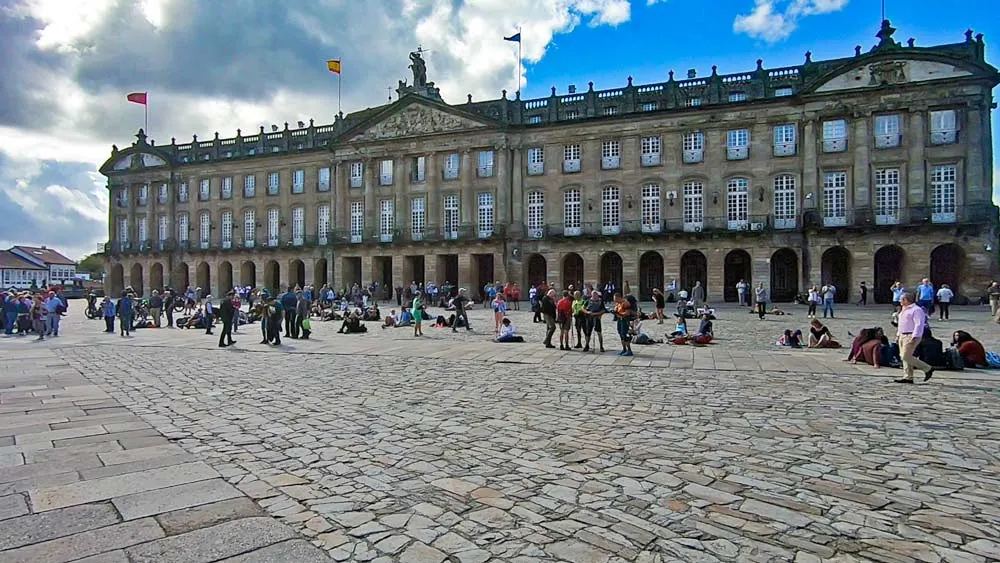
How to get the Compostela in Santiago?
To get your Compostela you have to go to the Pilgrim’s Reception Office located on Rúa das Carretas Street, 5min. walk from the cathedral. You go there first and take a number depending on the season you might wait for 30min. to a couple of hours. You don’t have to sit and wait there you can follow the queue online.
You’ll need your Credential and passport or ID (for EU citizens), it’s free. The Compostela contains your name and the date it was issued. If you want more personalized paper you can get the Certificate of Distance (both can be obtained at the same time) which has more personal details e.g. how far you walked, where you started etc. It costs 3 Euro.
For the last 100 km you need two stamps per day in your Credential, one stamp you get at the place you stay (it can be an albergue or a hotel every place on the Camino has its stamp), the second stamp you can get in a cafe, restaurant, bar or a church on the way. If you want, you can put more stamps on your Credential there are no limits.
Things to do in Santiago
There are many great things to do in Santiago de Compostela to keep you busy for a couple of days. The number one, of course, is to celebrate the end of the Camino. If you want to go out to celebrate, Rua do Franco is one of the best streets in the city for it. There are several tapas bars with a huge variety of tapas and drinks. For those who love seafood and fish I can recommend tapas bars Petiscos do Cardeal and Taberna do Bispo they have some delicious tapas. It was not expensive I paid between 6 and 7 Euro for 3 amazing tapas and a glass of wine.


The best guidebook for the Sarria to Santiago walk
John Brierly’s books for the Camino de Santiago in my opinion are by far the best and the most helpful guidebooks. For the Camino from Sarria, I can recommend his Pilgrim’s guide to the Camino de Santiago; Camino Frances.
Camino planning resources
Questions or Comments?
Got any questions or comments? We would love to help! All questions and comments will be answered by us personally in Buy Me a Coffee. Click below and ask away.
Feel free to support our site by buying us a coffee!
Please follow and like us:

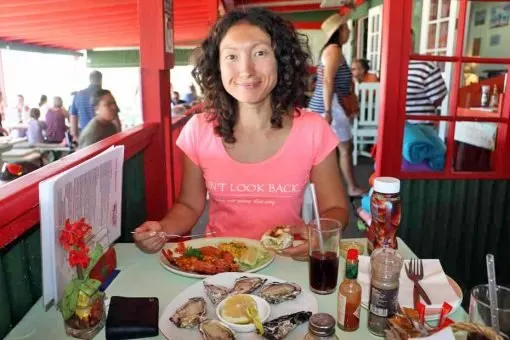
The pretty half of Stingy Nomads, responsible for all our land adventures (hiking, climbing, walking the Camino) and following them write-ups. Alya loves walking since she was a child, she prefers to walk 1000 km with a backpack rather than to do a 10 000 km road trip (actually any road trip). Alya is a big fan of Latin America, the Spanish language, and dancing. Every time we go away she desperately misses our dog Chile.





















Discussion about this post